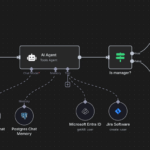Introduction:
Embarking on a career as a cybersecurity analyst is both challenging and rewarding, especially in the evolving landscape of digital security. For those aspiring to venture into the field in Pakistan, a strategic and well-informed approach is crucial. This blog post outlines ten essential steps to guide you on your journey to becoming a cybersecurity analyst in Pakistan.

Step 1: Understand the cybersecurity analyst Role and Responsibilities
Before delving into the cybersecurity field, it’s essential to gain a comprehensive understanding of the role and responsibilities of a cybersecurity analyst. This foundational step sets the stage for your educational and professional journey. Here’s a breakdown of what this step entails:
- Role Overview:
A cybersecurity analyst is a professional responsible for protecting an organization’s computer systems, networks, and data from cyber threats. Their primary goal is to ensure the confidentiality, integrity, and availability of information by implementing security measures and responding to security incidents. - Key Responsibilities:
Security Monitoring: Cybersecurity analysts continuously monitor networks and systems for unusual activities or security breaches. This involves using tools to analyze logs and detect anomalies that may indicate a potential threat. - Incident Response: When security incidents occur, analysts are at the forefront of response efforts. They investigate and mitigate security breaches, working to minimize damage and prevent future incidents.
- Vulnerability Assessment: Analysts conduct regular assessments to identify and address vulnerabilities in an organization’s systems. This involves scanning for weaknesses and recommending solutions to enhance security.
- Security Policy Enforcement: They ensure that security policies and procedures are followed across the organization. This includes implementing access controls, configuring firewalls, and enforcing encryption protocols.
- Threat Intelligence Analysis: Staying informed about the latest cyber threats is crucial. Cybersecurity analysts analyze threat intelligence to understand the tactics, techniques, and procedures employed by cyber adversaries.
- Security Awareness Training: Educating employees about security best practices is part of the role. Analysts may be involved in creating and delivering training programs to enhance the overall cybersecurity posture of the organization.
- Skills Required:
Understanding the required skills for a cybersecurity analyst is crucial for effective preparation. Key skills include: - Technical Proficiency: Proficiency in using cybersecurity tools, knowledge of programming languages, and a strong grasp of networking concepts are essential.
- Analytical Skills: The ability to analyze data, identify patterns, and draw meaningful conclusions is vital for assessing and responding to security incidents.
- Communication Skills: Effective communication is crucial for conveying complex security concepts to both technical and non-technical stakeholders.
- Problem-Solving: Cybersecurity analysts must be adept at solving complex problems, especially when responding to incidents or addressing vulnerabilities.
- Industry Standards and Frameworks:
Familiarize yourself with industry standards and frameworks such as: - NIST Cybersecurity Framework: A widely recognized framework that provides guidelines for improving cybersecurity posture.
- ISO/IEC 27001: An international standard for information security management systems.
- CIS Controls: Developed by the Center for Internet Security, these controls offer best practices for securing information systems.
Understanding the role and responsibilities sets a solid foundation for the subsequent steps, guiding your educational choices, skill development, and career aspirations within the cybersecurity field.
Step 2: Acquire a Strong Educational Foundation
Building a strong educational foundation is crucial for a successful career as a cybersecurity analyst in Pakistan. This step involves making informed decisions about your academic path, selecting the right degree, and gaining the knowledge necessary to excel in the field.
1. Choose a Relevant Educational Path:
Select a degree program that aligns with the requirements of the cybersecurity field. Common educational paths include:
Bachelor’s in Computer Science: A comprehensive program covering fundamental computer science concepts and programming languages.
Bachelor’s in Information Technology: Focused on information systems, networking, and IT management.
Bachelor’s in Cybersecurity: Specialized programs that provide in-depth knowledge of cybersecurity principles and practices.
2. Research Accredited Institutions:
Identify reputable institutions in Pakistan that offer accredited programs in computer science, information technology, or cybersecurity. Consider factors such as faculty expertise, industry connections, and program reviews.
3. Pursue Advanced Degrees (Optional):
While a bachelor’s degree is often sufficient to start a career, pursuing a master’s degree in cybersecurity or a related field can enhance your skills and increase your marketability. Many senior-level positions may require or prefer candidates with advanced degrees.
4. Explore Specialized Certifications:
In addition to formal education, consider obtaining industry-recognized certifications. Certifications validate your skills and demonstrate your commitment to professional development. Examples include:
CompTIA Security+: Entry-level certification covering foundational cybersecurity skills.
Certified Information Systems Security Professional (CISSP): A globally recognized certification for experienced cybersecurity professionals.
Certified Ethical Hacker (CEH): Focuses on ethical hacking and penetration testing skills.
5. Stay Informed about Industry Trends:
Cybersecurity is a rapidly evolving field, and staying informed about industry trends is essential. Engage with online forums, attend webinars, and read relevant publications to stay abreast of the latest developments in cybersecurity.
6. Practical Learning and Internships:
Look for programs that offer hands-on learning experiences and internships. Practical exposure allows you to apply theoretical knowledge in real-world scenarios, enhancing your skills and providing valuable experience for future employment.
7. Develop Soft Skills:
In addition to technical skills, develop soft skills such as communication, problem-solving, and teamwork. Effective communication is particularly important when conveying complex security concepts to non-technical stakeholders.
8. Network with Peers and Professionals:
Engage with your peers, professors, and professionals in the field. Attend industry events, join online forums, and participate in networking opportunities. Building a professional network can provide insights, mentorship, and potential job opportunities.
9. Consider Cybersecurity Competitions:
Participate in cybersecurity competitions to test and enhance your skills. Competitions like Capture The Flag (CTF) events provide practical challenges that mimic real-world cybersecurity scenarios.
10. Pursue Continuous Learning:
The field of cybersecurity is dynamic, and continuous learning is essential. Stay curious, explore new technologies, and consider pursuing additional certifications or advanced degrees throughout your career.
Step 3: Develop Technical Skills
Building technical skills is a crucial aspect of becoming a proficient cybersecurity analyst in Pakistan. These skills form the backbone of your ability to analyze and secure computer systems. Here’s a detailed guide on how to develop and strengthen your technical prowess:
1. Programming Languages:
Python: Widely used in cybersecurity for scripting, automation, and ethical hacking tools. Learn the basics of Python and explore its application in cybersecurity.
JavaScript, C, C++: Depending on your specific interests, knowledge of these languages can be beneficial, especially when dealing with security vulnerabilities at the application level.
2. Networking Concepts:
TCP/IP: Understand the fundamentals of the Transmission Control Protocol and Internet Protocol, as they are the foundation of network communication.
Subnetting and Routing: Familiarize yourself with subnetting techniques and routing protocols to grasp the intricacies of network security.
3. Operating Systems:
Linux: Gain proficiency in using Linux-based operating systems. Many cybersecurity tools and platforms are designed for Linux, and a solid understanding of the command line is essential.
Windows: Understand Windows operating systems, as they are prevalent in many corporate environments. Learn about user permissions, security policies, and event logging.
4. Cybersecurity Tools:
Wireshark: Master the use of Wireshark for packet analysis. This tool is essential for examining network traffic and identifying potential security threats.
Metasploit: Explore the Metasploit framework for penetration testing and ethical hacking. It’s a powerful tool for identifying and exploiting vulnerabilities.
Nmap: Learn how to use Nmap for network discovery and security scanning. Nmap helps identify open ports, services, and potential weaknesses.
5. Encryption and Cryptography:
SSL/TLS: Understand how Secure Socket Layer (SSL) and Transport Layer Security (TLS) protocols work for securing data in transit.
AES, RSA: Gain knowledge of common encryption algorithms like Advanced Encryption Standard (AES) and Rivest-Shamir-Adleman (RSA).
6. Web Security:
OWASP Top 10: Familiarize yourself with the Open Web Application Security Project’s (OWASP) list of the most critical web application security risks.
Cross-Site Scripting (XSS), SQL Injection: Learn about common web vulnerabilities and how to mitigate them.
7. System Administration:
Active Directory: Understand the basics of Active Directory, as it plays a crucial role in many corporate environments.
Firewall Configuration: Learn about configuring firewalls to control incoming and outgoing network traffic.
8. Virtualization and Cloud Computing:
VMware, VirtualBox: Gain hands-on experience with virtualization platforms to create and manage virtual environments for testing.
Cloud Platforms (e.g., AWS, Azure): Understand the basics of cloud computing and how security principles apply to cloud environments.
9. Incident Response:
Forensic Tools: Familiarize yourself with digital forensics tools for investigating security incidents. Tools like Autopsy or The Sleuth Kit are commonly used.
Security Information and Event Management (SIEM) Tools: Understand the role of SIEM tools in collecting and analyzing security event data.
10. Continuous Learning and Certifications:
Cybersecurity Certifications: Pursue certifications such as Certified Information Systems Security Professional (CISSP), Certified Ethical Hacker (CEH), or CompTIA Security+ to validate your skills.
Online Courses and Workshops: Enroll in online courses or workshops to stay updated on the latest technologies and best practices in cybersecurity.
Step 4: Gain Certifications
Earning industry-recognized certifications is a pivotal step in establishing your credibility and validating your expertise as a cybersecurity analyst in Pakistan. Certifications not only demonstrate your commitment to professional development but also enhance your employability. Here’s a comprehensive guide on gaining relevant certifications:
1. CompTIA Security+:
Overview: An entry-level certification covering foundational principles of cybersecurity.
Focus Areas: Network security, compliance and operational security, threats, and vulnerabilities.
Benefits: Widely recognized, it serves as a stepping stone for more advanced certifications.
2. Certified Information Systems Security Professional (CISSP):
Overview: A globally recognized certification for experienced cybersecurity professionals.
Focus Areas: Security and risk management, asset security, security architecture and engineering, communication and network security, identity and access management, security assessment and testing, security operations, and software development security.
Benefits: Demonstrates a high level of expertise and is often required for senior-level roles.
3. Certified Ethical Hacker (CEH):
Overview: Focuses on ethical hacking techniques and penetration testing.
Focus Areas: Information security, ethical hacking, penetration testing, footprinting and reconnaissance, system hacking, malware threats, and social engineering.
Benefits: Ideal for those interested in offensive security and identifying vulnerabilities.
4. Offensive Security Certified Professional (OSCP):
Overview: A hands-on certification emphasizing practical skills in penetration testing.
Focus Areas: Network penetration testing, web application penetration testing, and exploiting systems.
Benefits: Highly regarded in the industry, demonstrating practical expertise in ethical hacking.
5. Cisco Certified CyberOps Associate:
Overview: A certification by Cisco focusing on cybersecurity operations.
Focus Areas: Security concepts, security monitoring, host-based analysis, network intrusion analysis, and security policies and procedures.
Benefits: Ideal for those looking to specialize in cybersecurity operations.
6. GIAC Security Essentials (GSEC):
Overview: An entry-level certification covering a broad range of security topics.
Focus Areas: Information security fundamentals, access controls, cryptography, and network security.
Benefits: Provides a well-rounded understanding of essential security concepts.
7. Certified Information Security Manager (CISM):
Overview: A certification for information security management and governance.
Focus Areas: Information security governance, risk management, information security program development and management, and information security incident management.
Benefits: Ideal for those aspiring to move into cybersecurity management roles.
8. Certified Cloud Security Professional (CCSP):
Overview: Focuses on securing cloud environments and services.
Focus Areas: Cloud concepts, architecture, and design; data security and privacy; legal and compliance; and risk management.
Benefits: Relevant for cybersecurity professionals working in cloud security.
9. EC-Council Certified Security Analyst (ECSA):
Overview: A certification focusing on ethical hacking and penetration testing methodologies.
Focus Areas: Information gathering, vulnerability analysis, penetration testing, system analysis, and reporting.
Benefits: Complements the CEH certification, providing a more in-depth understanding of penetration testing.
10. Cybersecurity Analyst+ (CySA+):
Overview: An intermediate-level certification by CompTIA for cybersecurity analysts.
Focus Areas: Threat and vulnerability management, software and systems security, security operations and monitoring, and incident response.
Benefits: Validates skills in cybersecurity analytics and response.
Tips for Certification Pursuit:
Plan Your Path: Identify the certifications most relevant to your career goals and current skill set.
Study Resources: Utilize official study guides, practice exams, and online courses offered by certification bodies.
Hands-On Practice: Many certifications, especially practical ones, require hands-on experience. Set up labs or use virtual environments to apply theoretical knowledge.
Stay Updated: Certification exam content may change, so regularly check for updates and new exam objectives.
Networking: Engage with certification communities and forums to share experiences, get advice, and stay informed about changes.
Gaining certifications demonstrates your commitment to the cybersecurity field, enhances your knowledge, and makes you a more competitive candidate in the job market. Consider pursuing certifications that align with your career goals and the specific requirements of the cybersecurity industry in Pakistan.
Step 5: Stay Informed about Cyber Threats
Staying informed about cyber threats is a critical aspect of being a cybersecurity analyst in Pakistan. The cybersecurity landscape is dynamic, with threats constantly evolving. To effectively protect systems and data, you must be proactive in keeping up-to-date with the latest developments in the field. Here’s a detailed guide on how to stay informed about cyber threats:
1. Follow Industry Blogs and News:
Cybersecurity Blogs: Regularly read reputable cybersecurity blogs that provide insights into the latest threats, vulnerabilities, and best practices. Examples include Krebs on Security, The Hacker News, and Dark Reading.
Industry News Outlets: Follow cybersecurity news from reliable sources like CyberScoop, SC Magazine, and Threatpost to stay informed about major security incidents and trends.
2. Subscribe to Threat Intelligence Feeds:
Open Source Intelligence (OSINT): Subscribe to OSINT feeds that provide real-time information about potential threats. OSINT sources can include data from social media, forums, and other publicly available platforms.
Commercial Threat Intelligence Providers: Consider leveraging commercial threat intelligence services that offer detailed information on emerging threats, tactics, and vulnerabilities.
3. Attend Cybersecurity Webinars and Conferences:
Webinars: Participate in cybersecurity webinars hosted by industry experts and organizations. These events often cover specific threats, case studies, and emerging technologies.
Conferences: Attend local and international cybersecurity conferences to network with professionals, learn about cutting-edge research, and gain insights into the latest threat landscapes.
4. Engage in Online Forums and Communities:
Reddit Communities: Join cybersecurity-focused subreddits such as r/netsec and r/AskNetsec to engage in discussions, share insights, and ask questions within the cybersecurity community.
Professional Forums: Participate in professional forums like the Information Security Stack Exchange (Security.SE) to interact with peers and experts.
5. Continuous Training and Certifications:
Certification Renewal Programs: Many certifications require ongoing professional development, ensuring that certified professionals stay current with industry trends.
Training Platforms: Enroll in online training platforms such as SANS, Cybrary, or Coursera to access courses that cover the latest threats and defensive techniques.
6. Join Cybersecurity Threat Sharing Platforms:
Information Sharing and Analysis Centers (ISACs): Join industry-specific ISACs to share and receive threat intelligence with peers in your sector.
Threat Intelligence Platforms: Explore platforms like MISP (Malware Information Sharing Platform & Threat Sharing) that allow for the sharing and analysis of structured threat information.
7. Follow Security Researchers and Experts:
Twitter and LinkedIn: Follow cybersecurity researchers, experts, and organizations on platforms like Twitter and LinkedIn to receive real-time updates on security trends and news.
8. Read Research Papers and Publications:
Security Research Papers: Explore academic research papers and publications from reputable institutions and researchers. These often provide in-depth analyses of specific threats and vulnerabilities.
9. Participate in Capture The Flag (CTF) Challenges:
CTF Competitions: Engage in cybersecurity Capture The Flag challenges. These competitions simulate real-world scenarios, enhancing your practical skills in identifying and mitigating threats.
10. Set up Google Alerts:
Customized Alerts: Create customized Google Alerts for keywords related to cybersecurity threats in Pakistan. Receive email notifications whenever relevant news or updates are published.
Key Considerations:
Critical Thinking: Develop critical thinking skills to assess the credibility of information and distinguish between real threats and hype.
Collaboration: Collaborate with colleagues, share insights, and participate in information-sharing initiatives to strengthen the collective defense against cyber threats.
Practical Application: Apply your knowledge by testing and implementing defensive strategies in controlled environments to understand how threats operate.
Staying informed about cyber threats is an ongoing commitment that is crucial for a successful career in cybersecurity. By actively engaging with the cybersecurity community, participating in continuous training, and leveraging various sources of threat intelligence, you’ll be better equipped to protect systems and respond effectively to emerging cyber threats in Pakistan.
Step 6: Develop Analytical Skills
Cultivating strong analytical skills is paramount for success as a cybersecurity analyst in Pakistan. Analytical prowess allows you to interpret complex data, identify patterns, and respond effectively to security incidents. Here’s a detailed guide on developing and enhancing your analytical skills in the cybersecurity context:
1. Understand the Cybersecurity Data Landscape:
Log Analysis: Gain proficiency in analyzing log data generated by various systems. Understand how to extract meaningful information from logs to identify anomalies or potential security incidents.
Packet Analysis: Learn to analyze network traffic using tools like Wireshark. Understanding packet-level details is crucial for identifying suspicious activities and potential threats.
2. Learn Data Visualization Techniques:
Graphs and Charts: Develop the ability to represent complex data sets visually. Tools like Microsoft Excel, Tableau, or open-source alternatives can aid in creating effective visualizations.
Heat Maps and Timelines: Use heat maps to depict concentrations of activities and timelines to illustrate sequences of events. These visualizations enhance your ability to detect patterns.
3. Hone Critical Thinking Skills:
Scenario Analysis: Practice analyzing hypothetical cybersecurity scenarios. This exercise helps you think critically about the potential impact of security incidents and devise appropriate responses.
Incident Response Planning: Develop the ability to plan and execute incident response strategies. This involves assessing the severity of incidents, prioritizing actions, and coordinating response efforts.
4. Familiarize Yourself with Cyber Threat Intelligence:
Threat Intelligence Analysis: Understand how to analyze threat intelligence reports. This includes identifying indicators of compromise (IoCs) and understanding the tactics, techniques, and procedures (TTPs) of cyber adversaries.
Open Source Intelligence (OSINT): Leverage publicly available information to gather intelligence about potential threats. OSINT skills are valuable for understanding the broader threat landscape.
5. Develop Proficiency in Security Information and Event Management (SIEM) Systems:
SIEM Platforms: Gain hands-on experience with SIEM platforms like Splunk, ELK Stack, or others. These systems aggregate and analyze security events, providing valuable insights into network activities.
Correlation Rules: Understand how to create and customize correlation rules in a SIEM to detect unusual patterns or behaviors that may indicate a security incident.
6. Participate in Capture The Flag (CTF) Challenges:
CTF Competitions: Engage in cybersecurity CTF challenges that require analytical thinking and problem-solving. These challenges often simulate real-world scenarios, enhancing your ability to analyze and respond to security issues.
7. Continuous Training and Certification:
Security Certifications: Pursue certifications that emphasize analytical skills, such as Certified Information Systems Security Professional (CISSP) or Certified Incident Handler (GCIH).
Online Courses and Workshops: Enroll in online courses or workshops that focus on analytical techniques specific to cybersecurity.
8. Stay Updated with Industry Trends:
Read Research Papers: Explore academic research papers and industry reports that delve into analytical methodologies and emerging trends in cybersecurity.
Follow Analyst Blogs: Follow blogs of cybersecurity analysts and professionals who share insights into their analytical processes and experiences.
9. Enhance Communication Skills:
Reporting: Develop clear and concise reporting skills. The ability to communicate complex technical information to non-technical stakeholders is crucial for effective incident response.
Collaboration: Foster collaboration with colleagues and cross-functional teams. Sharing insights and collaborating on analyses can lead to more comprehensive threat assessments.
10. Participate in Threat Hunting:
Proactive Analysis: Engage in threat hunting activities to proactively search for signs of malicious activities within your network. This involves actively seeking out potential threats rather than waiting for alerts.
Key Considerations:
Real-World Application: Apply analytical skills in practical scenarios. Work on real-world projects, participate in simulations, and engage in hands-on activities to reinforce your analytical capabilities.
Continuous Feedback: Seek feedback on your analyses from mentors, peers, or experienced professionals. Continuous improvement is essential in developing analytical skills.
Mental Flexibility: Cultivate mental flexibility to adapt to evolving cybersecurity challenges. The ability to approach problems from different perspectives enhances your effectiveness as an analyst.
Developing strong analytical skills is an ongoing process that requires a combination of theoretical understanding, practical application, and continuous learning. By honing these skills, you’ll be better equipped to navigate the complex and dynamic landscape of cybersecurity in Pakistan.
Step 7: Gain Practical Experience
Gaining practical experience is a crucial step in becoming a proficient cybersecurity analyst in Pakistan. Practical exposure allows you to apply theoretical knowledge, develop hands-on skills, and familiarize yourself with real-world scenarios. Here’s a detailed guide on how to gain practical experience in the field of cybersecurity:
1. Seek Internships and Entry-Level Positions:
Internship Opportunities: Look for internship programs offered by cybersecurity firms, IT companies, or government agencies. Internships provide valuable hands-on experience and the opportunity to work on real-world projects.
Entry-Level Positions: Apply for entry-level positions that focus on security operations, network administration, or technical support. These roles can serve as a stepping stone to a cybersecurity career.
2. Volunteer for Cybersecurity Projects:
Nonprofit Organizations: Offer your services to nonprofit organizations or community groups that may not have dedicated cybersecurity resources. Volunteering allows you to contribute to meaningful projects while gaining practical experience.
Open Source Projects: Contribute to open-source cybersecurity projects. This not only provides hands-on experience but also allows you to collaborate with experienced professionals in the cybersecurity community.
3. Participate in Capture The Flag (CTF) Competitions:
Online Platforms: Join online CTF platforms that host cybersecurity challenges. CTF competitions simulate real-world scenarios and cover a wide range of cybersecurity topics, including cryptography, web exploitation, and reverse engineering.
Local CTF Events: Participate in local or national CTF events and competitions. These events often attract cybersecurity professionals and enthusiasts, providing networking opportunities.
4. Create a Home Lab:
Set Up a Virtual Environment: Build a home lab using virtualization software such as VirtualBox or VMware. Create virtual machines to simulate different operating systems, networks, and cybersecurity scenarios.
Practice with Security Tools: Install and configure cybersecurity tools in your home lab. Experiment with tools like Wireshark, Metasploit, and Snort to gain hands-on experience.
5. Contribute to Cybersecurity Research:
Research Projects: Engage in independent research projects related to cybersecurity. This could involve exploring new vulnerabilities, analyzing malware samples, or conducting experiments to test security controls.
Write Research Papers or Blogs: Document your findings by writing research papers or blogs. Sharing your insights with the cybersecurity community demonstrates your expertise and can enhance your professional profile.
6. Join Cybersecurity Competitions and Challenges:
Hackathons and Bug Bounty Programs: Participate in hackathons and bug bounty programs. These initiatives provide opportunities to identify and report security vulnerabilities in applications and websites.
Red Team/Blue Team Exercises: Engage in red team/blue team exercises with peers or security communities. These simulations replicate adversarial attacks and defensive responses, offering practical experience in a controlled environment.
7. Enroll in Cybersecurity Labs and Courses:
Online Platforms: Enroll in online platforms that offer virtual cybersecurity labs. Platforms like Hack The Box, TryHackMe, or PentesterLab provide practical exercises to improve your skills.
Certification Courses: Take certification courses that include hands-on labs. Certifications like Certified Ethical Hacker (CEH) and Offensive Security Certified Professional (OSCP) are known for their practical focus.
8. Network with Professionals in the Field:
Attend Meetups and Conferences: Attend local or virtual meetups and conferences related to cybersecurity. Networking with professionals in the field can lead to opportunities for collaborative projects or mentorship.
Join Online Forums and Communities: Participate in online forums and communities where cybersecurity professionals share experiences and insights. Platforms like Reddit (r/netsec) and specialized forums provide a space for learning from others.
9. Simulate Incident Response Scenarios:
Create Scenarios: Simulate incident response scenarios in your home lab. Practice detecting and responding to security incidents, including handling incidents such as malware infections or data breaches.
Use Security Information and Event Management (SIEM) Tools: Familiarize yourself with SIEM tools to analyze and respond to security events. Many SIEM platforms offer free or trial versions for hands-on practice.
10. Pursue Professional Development Opportunities:
Training Programs: Explore professional development programs and training offered by cybersecurity organizations. These programs often include practical exercises and case studies.
Mentorship: Seek mentorship from experienced cybersecurity professionals. A mentor can provide guidance, share insights, and help you navigate the challenges of gaining practical experience.
Key Considerations:
Document Your Work: Keep detailed records of your practical experiences, including the challenges you faced and the solutions you implemented. This documentation can be valuable for showcasing your skills to potential employers.
Stay Ethical: When conducting experiments or participating in cybersecurity challenges, always adhere to ethical guidelines. Respect privacy and legal boundaries, and avoid engaging in any activities that could be deemed malicious or illegal.
Continuous Learning: Practical experience is an ongoing journey. Embrace a mindset of continuous learning, regularly challenging yourself with new projects, scenarios, and technologies.
Gaining practical experience in cybersecurity is a hands-on process that requires dedication and a proactive approach. By actively seeking opportunities, collaborating with the cybersecurity community, and continuously refining your skills, you’ll be well-prepared for the challenges and responsibilities of a cybersecurity analyst in Pakistan.
Step 8: Network within the Industry
Building a professional network is a crucial aspect of advancing your career as a cybersecurity analyst in Pakistan. Networking allows you to connect with industry professionals, gain insights, and access valuable opportunities. Here’s a detailed guide on how to effectively network within the cybersecurity industry:
1. Attend Cybersecurity Conferences and Events:
Local and International Conferences: Attend both local and international cybersecurity conferences. Events such as DEFCON, Black Hat, and regional conferences provide excellent networking opportunities.
Virtual Conferences: Explore virtual conferences, webinars, and online events, especially if attending physical events is challenging. Many cybersecurity conferences now offer virtual participation.
2. Join Professional Associations:
ISACA (Information Systems Audit and Control Association): Join professional associations like ISACA, which focuses on IT governance, risk management, and cybersecurity. Attend chapter meetings and events to connect with industry professionals.
(ISC)² (International Information System Security Certification Consortium): Become a member of (ISC)², an organization that offers certifications like CISSP. Attend local chapter meetings and engage with the community.
3. Participate in Online Forums and Communities:
Reddit (r/netsec): Join the r/netsec subreddit and other cybersecurity-related subreddits. Engage in discussions, ask questions, and share your insights with the community.
Professional Forums: Participate in professional forums such as Information Security Stack Exchange (Security.SE) to connect with peers, seek advice, and share your knowledge.
4. Connect on LinkedIn:
Optimize Your Profile: Create a professional LinkedIn profile highlighting your skills, experiences, and certifications. Use a professional photo and craft a compelling summary.
Connect with Professionals: Connect with cybersecurity professionals, colleagues, and alumni on LinkedIn. Personalize connection requests with a brief introduction to enhance your networking efforts.
5. Attend Meetups and Networking Events:
Local Meetups: Attend local cybersecurity meetups, workshops, and networking events. Meetup platforms often host cybersecurity-related groups, providing opportunities for face-to-face interactions.
Organize Your Own Event: Consider organizing your own cybersecurity-related event or meetup. This initiative not only establishes you as a proactive professional but also attracts like-minded individuals.
6. Engage in Cybersecurity Challenges:
Capture The Flag (CTF) Competitions: Participate in CTF competitions and challenges. Engage with teammates, competitors, and organizers to expand your network within the cybersecurity community.
Bug Bounty Programs: Join bug bounty platforms and collaborate with other ethical hackers and security researchers. Platforms like HackerOne and Bugcrowd foster community engagement.
7. Seek Mentorship:
Identify Potential Mentors: Look for experienced professionals in the cybersecurity field who could serve as mentors. This could be a senior colleague, a speaker at a conference, or a contact you’ve made through networking.
Ask for Guidance: Approach potential mentors respectfully and express your interest in learning from their experiences. Seek guidance on career development, industry trends, and best practices.
8. Engage on Social Media:
Twitter: Follow cybersecurity experts, organizations, and influencers on Twitter. Engage in conversations, share relevant content, and use appropriate hashtags to expand your reach.
LinkedIn Groups: Join LinkedIn groups related to cybersecurity and actively participate in discussions. Share your insights and learn from the experiences of others.
9. Collaborate on Projects:
Open Source Contributions: Contribute to open-source cybersecurity projects on platforms like GitHub. Collaboration on projects allows you to work with others and establish meaningful connections.
Research Collaborations: Engage in collaborative research projects with professionals or organizations. Collaborative efforts often lead to networking opportunities and shared expertise.
10. Attend Training Workshops and Webinars:
Training Providers: Participate in cybersecurity training workshops and webinars. Many training providers organize networking sessions where you can connect with instructors and fellow participants.
Vendor Webinars: Attend webinars hosted by cybersecurity solution providers. These events often attract professionals interested in the latest technologies and trends.
Key Networking Tips:
Be Genuine: Approach networking with authenticity. Be genuine in your interactions, show interest in others, and be willing to share your experiences.
Follow Up: After networking events or connecting online, follow up with your contacts. Send personalized messages expressing your appreciation for the interaction and expressing interest in maintaining the connection.
Attend Social Events: Participate in social events associated with conferences or meetups. Informal settings provide opportunities for relaxed networking and relationship-building.
Develop a Personal Brand: Share your expertise through blogs, presentations, or online content. Developing a personal brand can enhance your visibility within the cybersecurity community.
Continuous Engagement: Networking is an ongoing process. Regularly engage with your network, share relevant content, and stay informed about the activities of your connections.
Building a strong professional network in the cybersecurity industry requires consistent effort and a genuine approach. By actively participating in conferences, joining professional associations, and engaging with the community both online and offline, you can create valuable connections that contribute to your success as a cybersecurity analyst in Pakistan.
Step 9: Create a Strong Online Presence
Staying current with industry trends is essential for any cybersecurity analyst, especially in the dynamic landscape of Pakistan. Continuous learning about emerging threats, technologies, and best practices ensures that you remain effective in safeguarding systems and data. Here’s a comprehensive guide on how to stay up-to-date with industry trends in cybersecurity:
1. Follow Reputable Cybersecurity Blogs:
Krebs on Security: Authored by journalist Brian Krebs, this blog covers a wide range of cybersecurity topics, including the latest threats, breaches, and investigations.
The Hacker News: A reliable source for cybersecurity news, providing updates on vulnerabilities, hacking incidents, and security research.
Dark Reading: A cybersecurity-focused publication offering in-depth articles, analysis, and commentary on current industry trends.
2. Subscribe to Cybersecurity News Outlets:
CyberScoop: A leading news source covering cybersecurity events, government initiatives, and the intersection of technology and security.
Threatpost: Offers breaking news, analysis, and research on cybersecurity trends, threats, and vulnerabilities.
SecurityWeek: Provides news, analysis, and insights into global cybersecurity trends and events.
3. Engage with Threat Intelligence Feeds:
Open Source Intelligence (OSINT): Leverage OSINT feeds to stay informed about potential threats and vulnerabilities. OSINT sources include social media, forums, and other publicly available platforms.
Commercial Threat Intelligence Providers: Explore services from commercial threat intelligence providers that offer detailed insights into emerging threats and attack methodologies.
4. Attend Cybersecurity Webinars and Virtual Events:
Industry Webinars: Participate in webinars hosted by cybersecurity experts and organizations. These events cover diverse topics, from new attack vectors to emerging technologies.
Virtual Conferences: Attend virtual conferences, which have become more prevalent, especially in response to global events. These conferences provide opportunities to learn about the latest industry developments.
5. Join Online Forums and Communities:
Reddit (r/netsec): Join the r/netsec subreddit and other cybersecurity-related subreddits. Engage in discussions, share insights, and stay informed about community perspectives on current trends.
Professional Forums: Participate in professional forums like Information Security Stack Exchange (Security.SE) to connect with peers and gain insights into industry discussions.
6. Follow Thought Leaders on Social Media:
Twitter: Follow cybersecurity thought leaders, researchers, and organizations on Twitter. Many professionals regularly share insights, research findings, and commentary on current trends.
LinkedIn: Connect with professionals and organizations on LinkedIn to stay updated on their posts and articles related to cybersecurity trends.
7. Enroll in Online Courses and Training Programs:
Specialized Platforms: Enroll in online courses on platforms like Coursera, edX, or Cybrary that cover the latest cybersecurity trends and technologies.
Training Providers: Explore courses offered by reputable training providers such as SANS Institute, Offensive Security, and EC-Council for specialized insights.
8. Read Research Papers and Publications:
Academic Journals: Explore academic research papers and publications on platforms like IEEE Xplore and ResearchGate. Academic research often delves into cutting-edge cybersecurity concepts.
Vendor Whitepapers: Review whitepapers published by cybersecurity solution providers. These documents often provide insights into new technologies and approaches to security.
9. Join Cybersecurity Threat Sharing Platforms:
Information Sharing and Analysis Centers (ISACs): Join industry-specific ISACs to share and receive threat intelligence with peers in your sector.
Threat Intelligence Platforms: Explore platforms like MISP (Malware Information Sharing Platform & Threat Sharing) that facilitate the sharing and analysis of structured threat information.
10. Engage in Continuous Learning:
Subscribe to Newsletters: Subscribe to newsletters from reputable cybersecurity organizations, news outlets, and threat intelligence providers to receive regular updates.
Online Courses and Workshops: Enroll in continuous learning programs, online workshops, and short courses to stay informed about the latest tools and techniques.
Key Considerations:
Diversify Your Sources: Gather information from a variety of sources to ensure a well-rounded understanding of industry trends. Relying on multiple sources helps validate information.
Critical Evaluation: Apply critical thinking when consuming information. Verify claims, consider the credibility of sources, and be discerning about the relevance of trends to your specific context.
Share Insights: Contribute to the community by sharing your own insights and experiences. Engaging in discussions and sharing knowledge enhances the collective understanding of cybersecurity trends.
Set Up Alerts: Configure alerts for keywords, industry terms, or specific topics using tools like Google Alerts. This ensures you receive timely updates on relevant news and trends.
Staying current with industry trends is a continuous process that requires dedication and a proactive approach to learning. By consistently exploring diverse sources of information, engaging with the cybersecurity community, and participating in continuous learning activities, you’ll be well-equipped to navigate the ever-evolving landscape of cybersecurity in Pakistan.
10: Pursue Professional Certifications
Earning professional certifications is a key component of becoming a highly qualified and recognized cybersecurity analyst in Pakistan. Certifications validate your skills, knowledge, and expertise in specific areas of cybersecurity. Here’s a detailed guide on pursuing professional certifications to enhance your cybersecurity career:
1. CompTIA Security+:
Overview: An entry-level certification covering foundational principles of cybersecurity.
Focus Areas: Network security, compliance and operational security, threats and vulnerabilities.
Benefits: Widely recognized, serves as a solid foundation for more advanced certifications.
2. Certified Information Systems Security Professional (CISSP):
Overview: A globally recognized certification for experienced cybersecurity professionals.
Focus Areas: Security and risk management, asset security, security architecture and engineering, communication and network security, identity and access management, security assessment and testing, security operations, and software development security.
Benefits: Demonstrates a high level of expertise and is often required for senior-level roles.
3. Certified Ethical Hacker (CEH):
Overview: Focuses on ethical hacking techniques and penetration testing.
Focus Areas: Information security, ethical hacking, penetration testing, footprinting and reconnaissance, system hacking, malware threats, and social engineering.
Benefits: Ideal for those interested in offensive security and identifying vulnerabilities.
4. Offensive Security Certified Professional (OSCP):
Overview: A hands-on certification emphasizing practical skills in penetration testing.
Focus Areas: Network penetration testing, web application penetration testing, and exploiting systems.
Benefits: Highly regarded in the industry, demonstrating practical expertise in ethical hacking.
5. Cisco Certified CyberOps Associate:
Overview: A certification by Cisco focusing on cybersecurity operations.
Focus Areas: Security concepts, security monitoring, host-based analysis, network intrusion analysis, and security policies and procedures.
Benefits: Ideal for those looking to specialize in cybersecurity operations.
6. GIAC Security Essentials (GSEC):
Overview: An entry-level certification covering a broad range of security topics.
Focus Areas: Information security fundamentals, access controls, cryptography, and network security.
Benefits: Provides a well-rounded understanding of essential security concepts.
7. Certified Information Security Manager (CISM):
Overview: A certification for information security management and governance.
Focus Areas: Information security governance, risk management, information security program development and management, and information security incident management.
Benefits: Ideal for those aspiring to move into cybersecurity management roles.
8. Certified Cloud Security Professional (CCSP):
Overview: Focuses on securing cloud environments and services.
Focus Areas: Cloud concepts, architecture, and design; data security and privacy; legal and compliance; and risk management.
Benefits: Relevant for cybersecurity professionals working in cloud security.
9. EC-Council Certified Security Analyst (ECSA):
Overview: A certification focusing on ethical hacking and penetration testing methodologies.
Focus Areas: Information gathering, vulnerability analysis, penetration testing, system analysis, and reporting.
Benefits: Complements the CEH certification, providing a more in-depth understanding of penetration testing.
10. Cybersecurity Analyst+ (CySA+):
Overview: An intermediate-level certification by CompTIA for cybersecurity analysts.
Focus Areas: Threat and vulnerability management, software and systems security, security operations and monitoring, and incident response.
Benefits: Validates skills in cybersecurity analytics and response.
Certification Tips:
Plan Your Path: Identify certifications that align with your career goals and interests. Consider the prerequisites and the knowledge areas covered by each certification.
Study Resources: Utilize official study guides, practice exams, and online courses provided by certification bodies or reputable training providers.
Hands-On Practice: Many certifications, especially practical ones, require hands-on experience. Set up labs or use virtual environments to apply theoretical knowledge.
Stay Updated: Certification exam content may change, so regularly check for updates and new exam objectives. Be aware of any changes to maintain the relevance of your certification.
Networking Opportunities: Attend certification-related events, webinars, or forums to connect with professionals who share similar certification goals. Networking can provide valuable insights and support.
Continuous Learning: Pursue certifications as part of your continuous learning journey. Consider earning multiple certifications to broaden your skill set and demonstrate expertise in different domains.
Certifications not only enhance your resume but also demonstrate to employers and peers that you have the knowledge and skills required for success in the cybersecurity field. Choose certifications that align with your career aspirations and contribute to your overall professional development as a cybersecurity analyst in Pakistan.
By following these steps with dedication and a proactive approach, you can position yourself for a successful career as a cybersecurity analyst in Pakistan. Remember that the cybersecurity field requires a commitment to lifelong learning and adaptability to thrive in the dynamic landscape of digital security.
Conclusion:
Becoming a cybersecurity analyst in Pakistan requires dedication, continuous learning, and a proactive approach. By following these ten steps, you can build a strong foundation, acquire the necessary skills, and position yourself for a successful career in the dynamic and crucial field of cybersecurity. contact Us for any query








